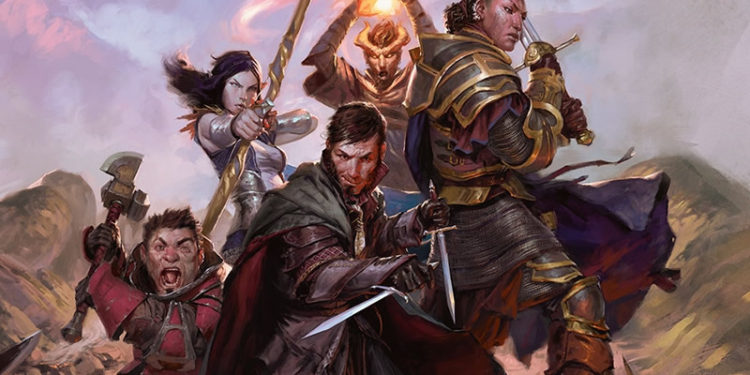
Oh hey, there’s a new Unearthed Arcana release today, the first of 2021! It’s giving us three new races lineages and signaling the future of lineage design for 5e, with the dhampir, hexblood, and reborn. There’s also a substantive lead-in and sidebar discussing the new ways we’ll see lineages presented, which I’ll cover first.
The byline here names F. Wesley Schneider, Ben Petrisor, and Jeremy Crawford, with input from the rest of the design team.
First Things First
The intro sidebar signals that some of the power balance may still be dodgy – which leaves one a touch curious as to what exactly this document is playtesting, but I suspect the answer is format. These lineages are things you can opt into at the start of play or later in the campaign, presumably with impetus from the story. I really like that out the gate – signaling that your half-vamp, little-bit-undead, or Six Million Dollar PC can become that as part of their arc. This is the exact kind of thing we tackled with the Cursed Soul in Seas of Vodari, and a lot (hi, Kobold Press! Hi, Explorer’s Guide to Wildemount!) of other official and third-party sources have done something similar.
- Ability Score Increases are now “+2 to something, +1 to something else, just… stop bothering us about it please and thank you.” This is especially important for these meta-lineages – if you enter the lineage late, these modifiers replace your starting modifiers. Sorry, races that get more than +3 total ASI!
- Languages are Common + 1. No surprise there. They specifically block off the silliness of changing your languages known if you enter this lineage after the start of play.
- Creature Type is a meaningful change. This document embraces up-front dual-typing. In previous releases we’ve only seen that buried in race features, such as the Fey Ancestry feature for elves. Importantly, effects work on you if they affect any of your types – so someone with Humanoid and Undead can be healed with cure wounds.
- Getting splashed with Turn Undead (because it is all undead) is a complicated point. Much worse is needing to figure out the CR of a PC to figure out if they eat a Destroy Undead.
The Aforementioned Sidebar That Tells the Future
This lays out a substantial shift in design thinking around the features you get from your character’s lineage. Ability Score Increase, languages, proficiencies, and alignment are all going away as something that even gets listed. The text calls out that alignment is “not a characteristic shared by a lineage.” The features that remain are physical or magical things, like darkvision and a breath weapon.
I like these changes, flat out. I would like to see someone get really clever and support mixed-lineage characters (such as a mix of human, dwarf, and orc forebears), but that’s outside the scope of this document. My other big takeaway is that this is throwing a huge bomb in to the third-party content creation space.
Finally, it explains that a “race” is a technical game term that means the body of features that you gain as a PC. In the same way that NPCs don’t follow class-and-level guidelines for anything other than spellcasting, they also won’t necessarily gain the features listed for races. Firmly divorcing PC mechanics from NPC mechanics was a major innovation of 4e that carried forward into 5e (because 3.x-style transparency creates so much extra work in building NPCs), and I’ll be curious to see how WotC releases use this going forward.
Dhampir
Let me start by saying that Blade is the only half-vampire that I like at all. If I step back from just generally disliking dhampir and think of these as “okay but I want to play a vamp PC and this is how,” I have a much easier time with it. What can I say, sometimes I’m a jerk about fine points of aesthetics. It’s a struggle.
- Dhampir have a particular hunger, which might or might not be blood. There’s a table of eight options. It’s unclear what “a color from one’s appearance” means, in terms of what other characters see happening, but the other forms of esoteric vampirism are cool in a horror-focused way. The hunger and self-control that sit at the center of, say, V:tM are absent here, left up to players to present in their roleplay. (And maybe gain Inspiration for, if they make that their Flaw).
- Dhampir Origins offers eight explanations for how you came to be like this. Notably, “something weird happened while your mother was pregnant with you” isn’t on the list. These explanations are interesting and they do meaningfully warm me to the concept. The text doesn’t completely call it out, but… Marvel’s Venom would be best represented with this lineage.
- Humanoid and Undead, of course.
- Size: Medium or Small. This is your reminder that a halfling, gnome, goblin, kobold, or whatever could become a dhampir. If Small size does anything in its own right, that’s not clear here.
- 35-ft walking speed. It’s your micro-Celerity! Congratulations.
- It does make sense for vamps to have darkvision, I’m just tired of darkvision now.
- Spider Climb gives you a climbing speed equal to your walking speed, and starting at 3rd level, you still have your hands free for fighting or spellcasting.
- Vampiric Bite is your core feature, and it’s super interesting.
- Con is your attack stat with it. It’s a simple weapon that you’re proficient with.
- 1d4 piercing damage + Con modifier.
- While you’re bloodied, you have advantage with it.
- Personally I’d like something that explicitly let you Sneak Attack with your bite – all that’s missing here is finesse.
- Anyway, you also get to empower the bite in one of two ways, proficiency bonus times per long rest: either you heal equal to the damage dealt, or you add the damage dealt to your ability check or attack roll.
I came in reluctant to like this thing, but I think they’ve done a good job with it. I’d strongly consider this as a PC, or as a twist in a PC’s story. Not being too attached to the definitions of dhampir that I’ve seen elsewhere was most of the work.
Hexblood
The story of this lineage is “you got cursed and,” while the physical description is “2e tiefling” – you have a random-ish assortment of sinister features, plus a “living crown” that gets unusual emphasis in description. The story talks about hags a lot, but I’m seeing it more as “person touched by the Gloaming Court.” I’m unironically looking forward to hexblood become just as popular as tieflings, with a huge boom in fan art.
…I just realized that Zagreus in Hades has a laurel that is totally a hexblood’s crown. So we’re getting a huge boom in hexblood fan art no matter what. Great work, folks!
- Hexblood Origins is a d8 table of ideas for why you’re a hexblood, and they’re covering a good bit of ground. That ground is known in other times and places as Changeling: the Dreaming and/or Changeling: the Lost, so you can probably guess that I am all about it.
- Fey and humanoid types.
- Small or Medium size. Oh man, I would totally go for a setting where goblins are just hexblood gnomes or halflings.
- Speed of 30 ft.
- Darkvision.
- Fey Resilience grants advantage on saves vs charmed, or to end that condition.
- Hex Magic gives you both disguise self and hex. You can cast one of those per long rest. Int, Wis, or Cha can be your casting stat. They’re also spells known that you can cast with your spell slots, if you have any.
- Magic Token lets you hand off a small body part – a tooth, fingernail, or lock of hair – once per long rest. As long as the person carrying it is within 10 miles, you can communicate through it (like message with a longer range), or you can expend the object to perceive through it for 1 minute.
I like the features here just fine. Giving more unusual-looking creatures a way to pass as something that won’t draw comment is important – you don’t really want the first several minutes of most social encounters to be about what the heck are you anyway? If you like urban fantasy at all, that’s why all the vampires, werewolves, fey, and whatever else can pass as human. They need a way to only look scary when they want to look scary.
Reborn
This is a concept that I am very interested in. Returned (revenants, basically) and homunculi (Frankenstein’s monster) were player races in the LARP that I worked on, so a way to put those into tabletop gaming are my deal.
- Lost Memories is a d8 table of a thing you remember at times of particular peace of stress. They all raise questions and suggest compelling stories – good piece of writing, that.
- Reborn Origins offers a bunch of different creation stories for your reborn, like you might expect. They’re all great, though I take umbrage (this is a joke) with not specifically listing The Nameless One’s origin story from Planescape: Torment. If you’re still sleeping on PS:T, fix that.
- Humanoid, plus either Construct or Undead.
- Medium or Small size.
- 30-ft speed.
- Darkvision.
- Deathless Nature gives you a pretty classic set (or adaptation thereof) of undead bennies. Advantage on saves against disease and poison (bless you for no immunities), resistance to poison damage, advantage on death saves, you don’t eat, drink, or breathe (…what do ya do), and you don’t sleep, can’t be put to sleep, and need just four hours of quiet and stillness per night.
- Interesting here to think about the Deathless of Aerenal in Eberron experiencing a minimal transition from living elves to “reborn.”
- Knowledge from a Past Life gives you +d6 to an ability check (“that uses a skill,” to block off initiative), proficiency bonus times per long rest. This is an interesting implementation; I’m a lot more accustomed to a feature by this name giving proficiency in something for a limited time. I like this one pretty well.
The downside of all of these lineages is that, in theory, you’re a modified version of an existing lineage, but you don’t keep any of the physical or magical traits of your original lineage. A dragonborn dhampir that can both bite you and breathe fire tells the story a bit more fully. But, well, I get why they did it this way.
That’s it for the document. I… wish we weren’t doing darkvision for everything, though I can’t pretend to be surprised that these gothic/creepy lineages get it. Look, I know it’s common to complain about darkvision – but my specific issue with it is about its passive use. It’s hard not to default to human capacities for perception while describing a scene, and every published adventure I’ve ever seen does it. Reworking that description for the characters with passive darkvision is a mental disruption that I resent, as a DM. I’d like to see it converted to an active, shorter-term thing.
Other than that, I like what I see here. I’d use ‘em – I don’t foresee a lot of problems. A setting with humans plus these three lineages would be completely valid and fun to me.



